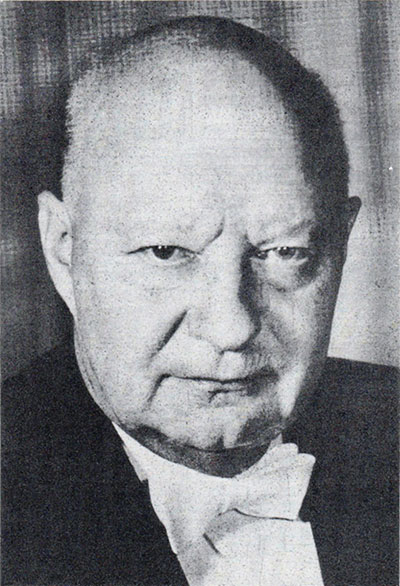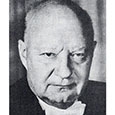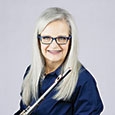 German composer, theorist, teacher, violist, and conductor Paul Hindemith rose to popularity between the two world wars and became one of the dominant musicians of the 20th century. When his music was banned in Germany in 1936, the composer fled to Switzerland and then to the United States. Born in Hanau, Germany in 1895, the eldest of three children, Hindemith entered the Hoch Conservatory at age 14 to study violin with Adolf Rebner. Later he learned music theory and composition from Arnold Mendelssohn, second cousin of Felix Mendelssohn-Bartholdy. At this stage of his career Hindemith admired the music of Brahms, Dvorak, Tchaikovsky, Mahler, Reger, Franz Schreker, Arnold Schoenberg, and Richard Strauss. He played first violin in the Frankfurt Opera Orchestra in 1914 and eventually became concertmaster.
German composer, theorist, teacher, violist, and conductor Paul Hindemith rose to popularity between the two world wars and became one of the dominant musicians of the 20th century. When his music was banned in Germany in 1936, the composer fled to Switzerland and then to the United States. Born in Hanau, Germany in 1895, the eldest of three children, Hindemith entered the Hoch Conservatory at age 14 to study violin with Adolf Rebner. Later he learned music theory and composition from Arnold Mendelssohn, second cousin of Felix Mendelssohn-Bartholdy. At this stage of his career Hindemith admired the music of Brahms, Dvorak, Tchaikovsky, Mahler, Reger, Franz Schreker, Arnold Schoenberg, and Richard Strauss. He played first violin in the Frankfurt Opera Orchestra in 1914 and eventually became concertmaster.
First Composition Period (1918-23)
At the onset of World War I Hindemith was drafted and played in a string quartet and a regimental band, but toward the end of the war he fought in the trenches, an experience that probably influenced his late-compositional style. Early 20th-century composers, such as Schoenberg and other 12-tone advocates, rejected traditional harmony and form and were known as expressionists. Like them Hindemith wrote such works as Sonata for Cello and Piano (1919), the one-act operas, Das Nusch Nuschi, Op. 20 (1920), and Sancta Susanna, Op. 21 (1921), and the song cycles Des Tades Tod, Op. 23a (1922) and Die junge Magd, Op. 23, # 2 (1922) in this style during his early career. He balanced the tension of the expanded harmonies with formal, traditional designs, such as sonata allegro form and theme and variations, although he did not write strictly in a 12-tone style.
Second Compositional Period (1924-33)
Historian Gustav Fredrich Hartlaub (1884-1963) first used the phrase Neue Sachlichkeit (new objectivity) to describe the social trend toward democracy in all areas of life. Music in this compositional style was functional and practical. During this stage in his development, Hindemith rejected expressionism and returned to writing clear musical lines, textures, and forms. He wrote Kammermusiken #2-7, a series of concertos that are similar to Bach’s Brandenburg Concertos. In Concerto for Orchestra (1925) Hindemith used a ritornello theme, and in vocal music he incorporated the text into the structure of the music. In Cardillac, an opera he wrote in 1925-6, Hindemith used such Baroque forms as fugues, passacaglia, variations, ostinatos, and arias.
From 1920 to 1930 Hindemith performed in the Amar Quartet and was on the program committee of the Donaueschingen Festival, one of the most important contemporary music centers of the day. While teaching at the Berlin Musikhochschule in 1927, he studied theory, acoustics, and also learned Latin and math in order to read the text of old treatises. Hindemith learned to play many of the early instruments in the Hochschule’s collection and gave private lessons. As technology developed, Hindemith dabbled in experimental music for the gramophone and taught a course in film music.
Third Compositional Period (1933-63)
Hindemith refused to stop performing with Jewish musicians after the National Socialists came into power in 1933. His wife was part Jewish, and he helped several Jewish friends escape from Germany. During this period Hindemith worked on Mathis der Maler, which became his most famous opera. It depicts a painter who temporarily leaves his art but triumphs after great tragedy and returns to being an artist. He used excerpts from the operatic score and some other material to create the symphonic work, which was premiered by the Berlin Philharmonic in 1934 with Wilhelm Furtwangler conducting. The work was well received, but within the year the political climate changed, and Hindemith swore a formal oath of allegiance to Hitler in an effort to appease the government. Furtwangler wrote a letter in support of Hindemith that was published in a major German newspaper, but despite this Goebbels accused Hindemith of cultural Bolshevism and banned his works in that country. Hindemith and Furtwangler consequently resigned their positions, and Hindemith focused on music theory and composition because he was unable to teach or conduct. He wrote The Craft of Musical Composition in 1937, a book that explained a new harmonic system based on natural laws of sound and the overtone series. This new tonal language, for which Hindemith is known, used perfect fourths and fifths instead of the triadic emphasis on thirds.
For a short period the Hindemiths lived in Switzerland but left for the U.S. a few months after the outbreak of World War II. Surprisingly, he composed 25 sonatas for almost every orchestral instrument during this time, as well as the Violin Concerto (1939), the Cello Concerto (1940), and the Symphony in Eb (1940). All of these works point to a more conventional style of composition. Yet intervals of the fourth and fifth governed his harmonic lines because Hindemith believed that they expanded the harmonic content of music.
In the United States Hindemith taught composition and theory at several major universities, most notably at Yale, and he wrote Exercises in Two-Part Writing (1939), A Concentrated Course in Traditional Harmony (1943), and Elementary Training for Musicians (1946). His continued fascination with early music led him to found the Yale Collegium Musicum (1945-1953), which performed early music in a historically-based style, long before Baroque performance practice became popular. He began to include isorhythmic passages, fugues, canons, and other contrapuntal devices in his music, culminating in Ludus tonalis (1942), a 20th-century counterpart to J.S. Bach’s WellTempered Clavier.
Hindemith became an American citizen in 1946 and later commuted between Zurich and New Haven as he taught in two universities. In this compositional period Hindemith often wrote for wind instruments because he thought they were underrepresented in the repertoire. He wrote in a style that reflects his return to discernable tonalties.
The city of Hamburg gave Hindemith the Bach Prize in 1952 for "distinguished service to German music." In his acceptance speech Hindemith said of Bach, "The literal heritage, his music proper, has conquered our souls as has hardly another master’s work. It was hidden and forgotten for a long time, like buried treasure in romantic tales, but finally several generations ago we found it again. We acquired it to possess it, to quote Fauste."1
Music for Flute
The most notable compositions Hindemith wrote for flute are the Canonic Sonatine for two flutes, Op. 31, # 3 (1924), 8 Pieces for Solo Flute (1927), Sonata for flute and piano (1936), and Echo for flute and piano (1942). Hindemith also composed several chamber works that include flute, most notably the woodwind quintet, Kleine Kammermusik, Op. 24, # 2 (1924 ). Other chamber works are the Septet for flute, oboe, clarinet, trumpet, horn, bass clarinet/bassoon, and bassoon (1948), and Speilmusik, Op. 43, # 1 for flute, oboe, and strings.
Hindemith wrote the flute sonata while working on Mathis der Maler. Richard Taruskin explained in The New York Times2 how this opera was a paradigm shift in the composer’s life. The main character of the opera, Matthias Grunewald, mirrors Hindemith’s life as he retreats from a world of class warfare and book burnings into the timeless world of art. Hindemith also admired Bach and during this time described him as one "who, two centuries later, proves to be a traditionalist in the stream of musical development."3 Baroque polyphony and the musical forms of the 17th and 18th centuries clearly inspired many of Hindemith’s works, including his flute sonata.
At the invitation of Oliver Strunk (1901-1980), chief of the Music Division of the Library of Congress, Hindemith was the featured guest at the 1936 Eighth Washington Festival of Contemporary Music, which was attended by the musical elite from all over the country. Georges Barrere (1876-1944) and pianist Jesus Maria Sanroma ( 1902-1984) premiered the flute sonata; other works on the program were Holderline Songs for tenor and piano, the Solo Viola Sonata, Op. 25.1, which Hindemith played; Four Songs on Old Texts for chorus, and a third piano sonata. In a subsequent letter to his wife, Hindemith wrote, "Barrere and Sanroma blew the flute sonata magnificently. They made a very good impression, the large audience responded warmly at once."
Less severe than many of Hindemith’s works, the flute sonata has three movements, the third of which is divided into two distinct and contrasting sections, a form that none of his other brass or wind sonatas use. The tonal language denies reference to any key, and key signatures do not occur in the score, although the tonal relationships between movements are Bb, B natural, Bb. Contrapuntal writing includes imitation, non-imitative counterpoint, pedal points, repetition, and sequences, as well as more modern techniques of planing or parallelism and quartal harmonies.
At first Hindemith referred to the sonata as an example of Gebrauchsmusik or music for a purpose, such as music written specifically for amateurs to play. Later he objected to the term and said that music should be "human, purposeful, absolute, and above all, accessible to all and utilitarian."4 That the work is now considered standard repertoire proves that Hindemith’s goal was met.
1 Paul Hindemith, Johann Sebastian Bach (New Haven: Yale University Press, 1952) p. 25.
2 Richard Taruskin, "In Search of a ‘Good’ Hindemith Legacy," New York Times (January 8, 1995), p. 30
3 Taruskin, "Hindemith Legacy," p. 30.
4 Jean Mary Ohlsson, "Paul Hindemith’s Music for Flute: Analysis of Solo Works and Stylistic and Formal Considerations of Chamber Works," (D.M.A. diss., Ohio State University, 1975), p. 14.






